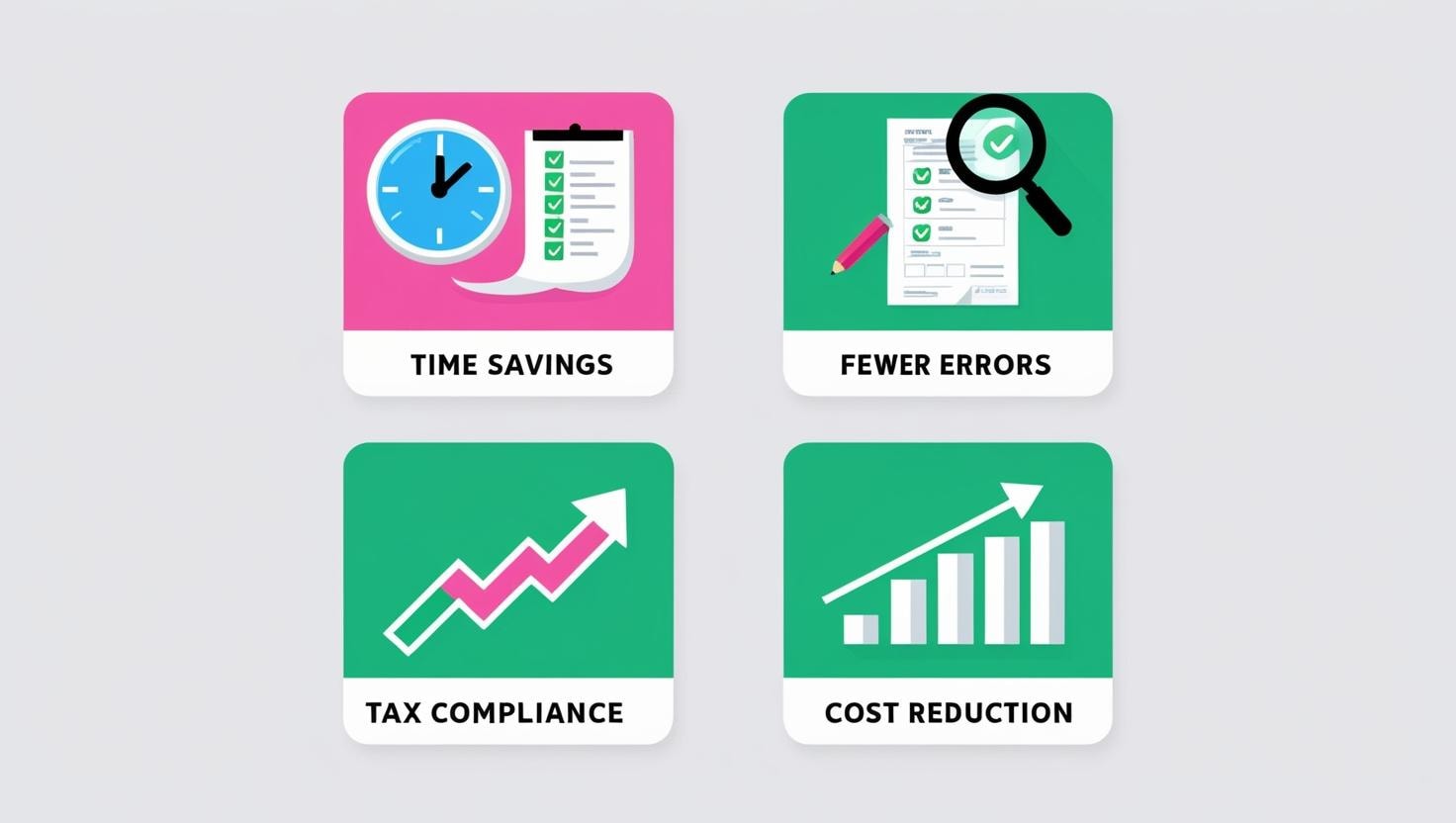In today's fast-paced business environment, where precision matters and time is limited, more and more companies are turning to an automated payroll systems to manage payroll better and ensure tax compliance. So, how does an automated payroll system work? And why does it matter so much now?
What is payroll automation?
Payroll automation is the process of using payroll software or a digital payroll system to handle payroll, including paying employees, tax withholdings, benefits, and pay slip generation. With automated payroll software, businesses can significantly reduce the risk of errors, save time, and ensure compliance with ever-changing labor and tax laws and regulations. This efficient payroll system allows companies to focus on growth while ensuring their payroll operations are accurate, timely, and hassle-free.
Benefits of payroll automation
Every growing business reaches a point where the old ways start to show cracks. Maybe it's an unexpected error during manual data entry, employee payments, or a delay in tax filing that causes last-minute stress. Or perhaps it's just the realization that things are taking far too long, every month. That's where payroll automation comes in, not to replace people, but to support them by automating routine processes. Payroll automation also enables real-time pay visibility, allowing employees to see their upcoming checks.

With an automated payroll system, calculations run in the background, pay slips are sent out on time, taxes are filed correctly, and it can significantly lower operational costs and lighten administrative burdens. The process becomes more oversight and strategy than data entry and damage control. And importantly, it ensures consistency and supports the generation of detailed, comprehensive payroll reports.
How to get started with payroll automation
Implementing payroll automation starts with understanding where you are today. That means taking a hard look at your current payroll process. What parts feel slow or inefficient? Are you duplicating tasks or entering the same data into multiple systems? Do employees have trouble accessing their pay slips or updating their information? Taking stock of your payroll process helps pinpoint what you actually need from a new payroll software.
From there, choosing the right payroll software becomes much easier. Some companies prefer standalone payroll automation software; others want something integrated with their HR or accounting software. The best system is the one that aligns with your workflow, not the other way around.
Once you've selected your platform, the next step is data migration. Most modern payroll software offers import tools to help with that, but it's still wise to double-check details from salaries and tax codes to bonuses and benefits.
Better data, smarter processes
One of the biggest challenges of manual payroll is employee data management across different places. Employees' wages, job titles, work hours, bonuses, deductions, tax laws, when this information lives in disconnected systems or spreadsheets, it's easy for inconsistencies to arise in complex payroll. An automated payroll software system centralizes payroll data, turning it into a single source of truth.

That means when someone changes roles or gets a raise, that update doesn't need to be entered in three different places. The change is made once and reflected everywhere it needs to be. That kind of efficiency is hard to match manually. Automation also improves how your systems communicate with each other. When integrated with your HR software or time-tracking tools, payroll becomes even easier with automated payroll systems. Vacation days, sick leave, and overtime all flow directly to payroll calculations without manual input.
Finding the right payroll software
There's no one-size-fits-all payroll automation software, and that's a good thing because it reduces the burden of manual processes. The best solution is one that directly addresses your company's unique pain points and helps you save money.
Start by identifying the bottlenecks. Are you constantly correcting payroll errors or dealing with late salary calculations? Then you'll want a system known for its reliability and built-in error detection. If your biggest challenge is staying up to date with Dutch labor laws and tax regulations, focus on payroll solutions with strong compliance management customised for the Netherlands.
Payroll automation software example
Cloud-based payroll systems are increasingly popular to manage payroll for a good reason. They significantly reduce administrative burdens by automating routine tasks, updating tax rules automatically, and making payroll accessible from anywhere. But no matter what system you choose, testing how payroll automation works and its software capabilities before going live is essential. A proper test run helps catch inconsistencies, validate payroll calculations, and ensure everything complies with local, state, and federal regulations.
Training is another often-overlooked step. Even the most advanced software won’t deliver results if your HR and payroll team doesn’t know how to use it. Investing time in onboarding and training ensures smoother adoption, fewer errors, and long-term success.
Automating payroll processes
Every month, salaries are calculated and scheduled automatically. Pay slips are generated and sent to employees along with their payroll records, detailing their employee benefits, without delay. Tax filings go out on time. Year-end reports are ready when you need them to generate reports for review.

But an automated system goes deeper. Some platforms use AI to spot inconsistencies. For example, if someone suddenly logs twice the normal hours or receives a duplicate bonus, the system flags it for review before payroll calculations are processed. It’s like having an extra set of eyes on your payroll.
You can also set up custom rules like bonuses for sales targets or auto-deductions for unpaid leave, so the software fits the way your business works, incorporating new automated payroll processes.
Overcoming manual payroll challenges
Manual payroll may seem manageable when your team is small. But as your business grows, so do the cracks. Tasks take longer, payroll errors become more common, and keeping everything compliant feels like a lot. Payroll automation helps your payroll teams avoid those growing pains. It frees up your team to focus on more strategic work, while the payroll system takes care of repetitive calculations and reporting in the background.
It also brings consistency. Mistakes that come from manual data entry don't happen when everything is automated. The result? A smoother process with accurate payroll data, fewer errors, and happier employees who get timely payments.
Data management and security
Payroll data is the most sensitive information your company handles, and the payroll automation system takes protection seriously. Modern payroll management tools come with secure data management, encryption, user access controls, and full compliance management with tax deductions, withholdings, and privacy laws like GDPR. This means your data stays safe and is only accessible to people such as the payroll manager.

On top of that, many systems offer employee self-service portals. Employees' bank accounts can be updated, or can manage their benefits securely and independently through self-service. It's a win-win: employees get transparency and control, and your HR and payroll team get fewer admin requests.
Key features of automated payroll
When evaluating payroll automation software, it’s necessary to look for key features that will make a difference for your business. Some of the most important include:
-
Automated tax calculations: Ensures accurate tax deductions based on the latest regulations, minimizing payroll errors and streamlining operations.
-
Real-time reporting: Offers instant access to payroll reporting, providing managers with insights into labor costs and financial performance.
-
Integrations: Seamless connection to your HR and financial systems, ensuring accurate and consistent employee data flow across all platforms.
-
Employee self-service: Allows employees to view their pay details, update personal employee information, and manage their benefits.
Conclusion
Payroll might never be the most glamorous part of running a business, but it is one of the most important. With the right workforce management tool, you can turn payroll operations into a smart, efficient, and secure process that runs quietly in the background while your team focuses on growth.
So, if you're still relying on spreadsheets or scrambling to meet tax filing each month, it might be time to ask: what would your business look like if payroll services just worked?








-1.png?width=446&height=493&name=Ditta%20van%20Gent%20Fotografie-45-1%201%20(1)-1.png)